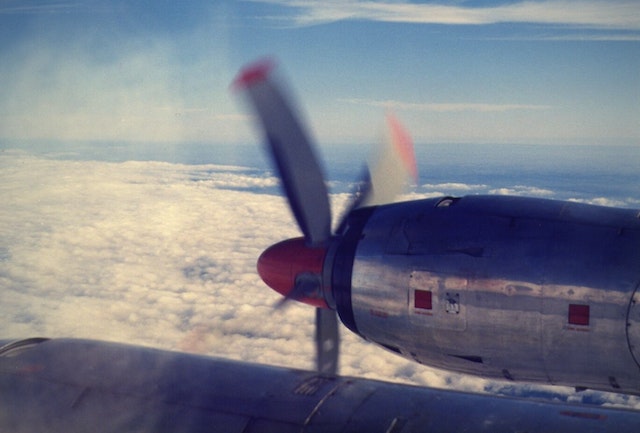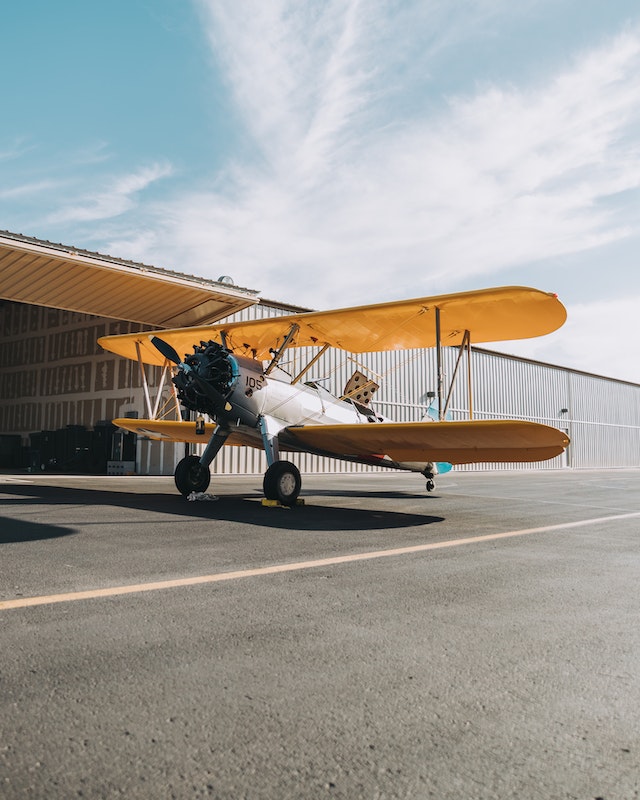In traditional times we often came across movies such as Indiana Jones or maybe some other military movie where we could see traditional aircraft with two pairs of wings, but it was a rare view in real life. The first aircraft to take flight in the sky was a double-winged airplane.
The basic question arises where did these airplanes disappear? Do they exist? Let’s answer these questions in this article.
Table of Contents
What Is A Double-Winged Airplane Called?
Few airplanes are not designed with single pair of wings. Indeed, some are specially designed with two pairs of wings, one pair of each wing stacked to the other. These planes are popularly known as b-planes; they have existed for more than a century.
These planes were first introduced by the Wright brothers, who took the initiative of building the first powered biplanes. In this article, we shall further discuss the topic and what are the basic differences between traditional airplanes and private commercial jets.
Biplanes or two-winged airplanes can mainly be described as airplanes with two pairs of wings. A pair of wings are attached to either side of a biplane. Its design is known as a biplane.
Regular airplanes have only a single pair of wings. Most commercial and private planes have monoplane designs. Biplanes have not become obsolete.
The Wright Flyer
The Wright Flyer initiated its flight in 1903. And the beginning of the timeline of the dynamic flight was none other than a biplane. The biplane facilitated a rigid structure without including those extra weights into the aircraft’s basic design.
The bracing structure was included in the middle of the wings. It allowed the wings to be manufactured from a lighter and thinner material which permitted the overall structure of the biplane to be lightweight yet strong than the commercial monoplane design of those times.
When two wings are stacked on top, their size is double the area. Hence, the span of the wings allowed is supposed to be limited and short. It leads to improved stiffness of the biplane.
During those initial stages, primarily used for biplanes, Engines were much less dynamic than today’s power plants. Hence, weight became a prime factor with reduced power. It didn’t simply mean that the aircraft had lower velocity, which automatically increased the drag.
Advantages Of Biplanes
Though we don’t regularly find a monoplane wing design, biplanes still have unique advantages. The wings of biplanes are much lighter than traditional airplanes. This is only because of a single reason: biplanes have two pairs of wings. Specifically speaking of biplanes, each pair includes 2 sets of wings and has lighter wings than their counterpart in traditional monoplanes.
A few more advantages of by planes are:
- Their specific slow take off
- Ideal landing speeds and short wings were useful in the wilderness. Especially where the terrain was rugged and had several adversities to it.
Biplanes have an increased roll rate when compared to the average monoplane. And if the configuration has reduced control forces, it automatically implies that role rates would be impressive. But when comparing pits, they have almost double the roll rate as the Super Decathlon.
Disadvantages Of Biplanes
There are a few noticeable disadvantages with biplanes. For instance, they create a lot more drag than regular monoplanes. Though the double wings generate lift, the drag created by it is more problematic, which certainly is not the case with monoplanes.
The velocity generated by biplanes is not a match to the traditional monoplanes. The top speed is low, which doesn’t allow for transportation. Regular monoplanes can fly faster with more velocity because they depend only on a single pair of wings. The traditional single wings reduce drag.
Why Did Old Planes Have Two Wings?

The primary reason for old planes to have double wings in the initial years was the insufficient infrastructure and materials to provide optimum strength.
During the beginning age of aviation, the only materials available for producing aircraft were timber doped and a few other materials. The product made of these materials was neither dynamic nor durable, which ultimately caused limiting the size of the wing.
In the initial stages of production, the aircraft had much less powerful engines resulting in lower velocity. But with the invention of strong materials like aluminum alloy, the aerodynamic short comes of biplanes became evident for two people, and monoplanes steadily became the preferred choice.
With the material’s strength improvement, the aspect ratio became larger. Regardless of all buy, planes are still being used. The optimum maneuverability and reduced stall speed have made them popular among aerobatic aircraft.
Takeoffs And Landings
Biplanes always produce sufficient lift at minimum air speeds; hence the take-off roll is necessarily shorter than the regular commercial monoplanes. Through numerous STOL monoplanes, the scene amongst the Bush flying community has proved to perform better than biplanes.
A biplane can fly at a very low speed, implying that the plane has two dissipate reduced energy to halt.
Many biplanes have tail wheels, for those taxing can be full of hurdles than a typical monoplane. Those who buy planes with tailwheel aircraft usually depend on a series of S turns to allow the pilot to see what’s in front of him.
Most biplanes are open or bubble canopies, facilitating optimum visibility above your aircraft. But at times, the lower wing of the biplane below the fuselage can obstruct the visibility under your aircraft.
Though most biplanes are tandem seating, your visibility can be affected throughout any stage of your flight, depending on your location.

Maintenance
Regular maintenance of a biplane adds a little extra effort compared to a monoplane. You should remember that most biplanes are used for aerobatics and environments that result in increased loading to the frame. It simply means that inspection of all the machinery and both the wings must be checked.
At times cleaning can also be hectic when dealing with a biplane just because there is an increase in the surface where the potential build-up is also more.
The strut that attaches the two wings is also a vital area that demands are little more effort to be cleaned. These struts at times increase the level of potential corrosion.
Do Biplanes Still Exist?
biplanes are two-winged airplanes and are not that popular these days. During the initial years, agents of aviation bought popular planes. Still, with the invention of monoplanes and private commercial planes, the industry has changed its choice.
Regardless, they are still widely and popularly used in acrobatic training and by the air show industry. Most biplanes are purpose-built specifically to be high-performance aircraft; hence they are not regularly used in the primary training of pilots.
A few modern biplane designs remain in specialist roles like agriculture aircraft. During the initial stages of flight, the pros of the planes outweighed the cons. But with the invention and technological advancement, monoplanes became dominant.
One of the primary reasons biplanes become obsolete is that they are inefficient and not as efficient as a monoplane.
It creates a humongous amount of drag compared to the amount of lift they generate. It implies that the fuel used by biplanes to travel a particular distance is much more when compared to that of a monoplane. Their visibility is low, which is sometimes considered a negative trait.
To sum up, we can say that their mechanism is much more complex when compared to that of a monoplane; they are less efficient with low maneuverability.
Double-Winged Airplanes were Used in World War 1 (WW1)
Biplanes were popularly used during the WW1, the only reason being the technology was not that advanced in those early ages, leaving them with no other choice but the biplanes. With the advancement of science, the monoplane was superiorly manufactured; it generated optimum speed.
There were a handful of biplanes that were used during WWII. The Fairey Swordfish Torpedo bomber1 was fairly used by people known for its increased speed and good lift, which allowed it to carry a heavy torpedo. Though the drag issues hardly matter for the reduced speeds they needed to fly just to be able to drop the torpedo on its exact target.
They were Gloster Gladiator (UK) and Polikarpov I-15 ( Soviet Union), which gained popularity initially but were outclassed when they had to compete even with early-war monoplanes.
The popular An-2 biplane is still in use today because of its low and perfect landing capabilities. And with its superior low stall speed can land anywhere, quite similar to that of a parachute.
Why Do Older Airplanes Have A Wing On Both The Top And The Bottom?
The prime spar used in older airplanes is two thin and fragile, and many times, it has been visibly seen that it was prone to bending when it had to provide support to the entire aircraft in a single span.
Only with the use of two wings was it possible to support and take the entire weight of the aircraft. The upper wing worked as a compression member, and the lower wing worked as an attention member of a truss.
The short length of the wings in a biplane also reduced the load on the wings. Biplanes are usually known to have an increased lift. It’s just because of their extended wing area, but it is also to be remembered that it produces a lot of drag.
Why Did They Stop Making Biplanes?
Frequently questions were asked: Are there any aerodynamic reasons for which the idea of manufacturing biplanes was completely rejected? During WW1 and WW2, all the aircraft that were used were nothing other than biplanes because there was no advanced development in the aircraft industry. But with improved structural techniques, durable materials, and optimized speed, people were left with multiple choices. There is a varied range of reasons why biplanes were rejected. Let’s discuss a few major reasons.
Biplanes were often considered inefficient, and their efficiency was quite low compared to their modern counterpart, the monoplane.
Another reason is its structural mechanics. As the cantilevered wing was modernized and construction became lightweight, the spotlight was directed to monoplanes.
A monoplane comprises dynamic aluminum alloys that facilitate several advantages to the aircraft designers that bring out the advanced traits of a monoplane, like its much-reduced drag. During the World War, the transition was facilitated because the high-performance military fighters exclusively manufactured made the monoplane the prime choice of all aircraft designers.
Final Verdict
If you are in search of a nostalgic aircraft that includes high ‘g’ Loading and has the potential to flip the world upside down, then a biplane would just be an absolute fit for you.

